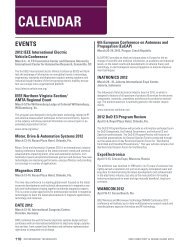2011 EMC Directory & Design Guide - Interference Technology
2011 EMC Directory & Design Guide - Interference Technology
2011 EMC Directory & Design Guide - Interference Technology
Create successful ePaper yourself
Turn your PDF publications into a flip-book with our unique Google optimized e-Paper software.
B o r g s t r o m<br />
testing & test equipment<br />
designed to represent the induced effects<br />
to internal aircraft wiring in response<br />
to an external aircraft lightning<br />
strike of a multiple burst nature (see<br />
Figure 6). The specified test waveform<br />
is applied to the cable bundle or wire<br />
under test, and repeated for at least 5<br />
minutes in each polarity.<br />
Equipment categories<br />
Category designations consist of six<br />
characters that describe the pin and cable<br />
test Waveform Sets and test levels.<br />
The 3 Pin Injection test waveforms<br />
are grouped together in two Waveform<br />
Sets (A & B). The 6 Cable Bundle test<br />
waveforms are grouped together in<br />
four Single Stroke Waveform Sets (C<br />
through F), and four combined Single<br />
Stroke and Multiple Stroke (G through<br />
K), and two Multiple Burst Waveform<br />
Sets (L& M).<br />
What’s new for DO-160G?<br />
• Users <strong>Guide</strong> added, resulting in<br />
many notes and remarks being moved<br />
from the requirements section to the<br />
Users <strong>Guide</strong>. A vast amount of additional<br />
(helpful) information is included<br />
in the Section 22 Users <strong>Guide</strong>.<br />
• The “resistor method” for determining<br />
the source impedance of the<br />
Pin-Injection test waveforms has been<br />
eliminated.<br />
• Cable Bundle test Waveform 6 was<br />
added, for the Multiple-Burst test only.<br />
See Figure 3.<br />
• Pin-Injection calibration and test<br />
setup figures were revised for clarity.<br />
SECTION 23: LIGHTNING<br />
DIRECT EFFECTS<br />
The tests in this section are performed<br />
to determine the ability of externally<br />
mounted electrical and electronic<br />
equipment to withstand the direct<br />
effects of a severe lightning strike.<br />
The equipment will not normally be<br />
powered during the test, and these<br />
tests usually cause damage (sometimes<br />
spectacular damage) to the EUT. High<br />
voltage and/or high current tests at<br />
levels of thousands of kilo-Volts and/<br />
or hundreds of kilo-Amps are required.<br />
Equipment categories<br />
Category designations consist of four<br />
characters that describe the nature and<br />
severity of the test waveforms applied.<br />
The first 2 characters designate the<br />
High Voltage Strike Attachment test<br />
category, and the last two characters<br />
designate the High Current Physical<br />
Damage test category. The designated<br />
test category for the EUT should correspond<br />
to the lightning strike zone<br />
in which the EUT will be installed on<br />
the aircraft.<br />
What’s new for DO-160G?<br />
• No changes.<br />
SECTION 25: ELECTROSTATIC<br />
DISCHARGE (ESD)<br />
This test determines whether the<br />
EUT can operate as specified during<br />
and after being subjected to an electrostatic<br />
air discharge event. The test<br />
procedure and test generator used is<br />
similar to most other international<br />
ESD standards, except that the EUT is<br />
bonded to the ground plane and only<br />
air discharge is specified. Test points<br />
are chosen based on their accessibility<br />
to personnel, with 10 positive and 10<br />
negative polarity discharges at 15 kV<br />
applied to each one.<br />
Equipment categories<br />
There is only one category (A), with a<br />
test level of 15 kV.<br />
What’s new for DO-160G?<br />
• Clarification of applicability of test<br />
points, in particular, stating that<br />
connector pins are not to be tested.<br />
THE LATEST FROM SC-135<br />
At the most recent meeting of the<br />
RTCA Program Management Committee<br />
(which directs the activities of SC-<br />
135), where Revision G of DO-160 was<br />
approved, the decision was made to allow<br />
for a minimum of 5 years until another<br />
revision of DO-160 was released.<br />
The Program Management Committee<br />
revised the “Terms of Reference”<br />
for SC-135 to create a “stand-alone”<br />
document (possibly in the form of an<br />
appendix) that would contain all the<br />
Users <strong>Guide</strong> material for all sections of<br />
DO-160. Although no target date was<br />
given for the release of this new Users<br />
<strong>Guide</strong>, it is to be completed before the<br />
committee resumes work on the next<br />
revision of DO-160 (DO-160H).<br />
SUMMARY<br />
RTCA/DO-160, and its European<br />
twin, EUROCAE/ED-14, are truly the<br />
world standards for Electromagnetic<br />
Compatibility requirements for aircraft<br />
electronic equipment.<br />
The test levels, requirements, and<br />
procedures are intended to reflect the<br />
"state-of-the-art" in aviation technology<br />
and <strong>EMC</strong> testing methodology.<br />
Since both aviation technology and<br />
<strong>EMC</strong> testing methodology are evolving<br />
at a rapid rate, work is continuing on a<br />
comprehensive Users <strong>Guide</strong> covering<br />
all sections of RTCA/DO-160G and<br />
eventually, the next revision, DO-160H.<br />
REFERENCES<br />
• [1] RTCA/DO-160F, "Environmental Conditions<br />
and Test Procedures for Airborne<br />
Equipment," RTCA, Incorporated, December<br />
2007.<br />
• [2] RTCA/DO-160D, "Environmental Conditions<br />
and Test Procedures for Airborne<br />
Equipment," RTCA, Incorporated, July 1997.<br />
• [3] MIL-STD-461F, "Requirements for the<br />
Control of Electromagnetic <strong>Interference</strong><br />
Characteristics of Subsystems and Equipment,”<br />
Dept. of Defense Interface Standard,<br />
December 2007.<br />
Erik J. Borgstrom has worked in the <strong>EMC</strong><br />
testing field for more than 24 years. He currently<br />
holds the position of <strong>EMC</strong> Operations Manager<br />
for Environ Laboratories LLC, and specializes<br />
in the <strong>EMC</strong> testing requirements for the Defense<br />
and Aerospace industries. Borgstrom is an active<br />
member of SAE Committees AE-2, where he leads<br />
the DO-160 Section 22 Task Group. He was also<br />
a member of the AE-4 (HIRF) Working Group,<br />
which worked on SAE document ARP5583 (HIRF<br />
Users <strong>Guide</strong>) Revision A, published in 2010.<br />
Borgstrom is one of Environ’s representatives<br />
to RTCA, where he serves on Special Committee<br />
135, as Change Coordinator for Section 22<br />
(Lightning Induced Transient Susceptibility) and<br />
Section 25 (ESD) of DO-160. He can be reached at<br />
ejb@environlab.com n<br />
MORE ON OUR website<br />
Read more about this topic at the<br />
<strong>Interference</strong> <strong>Technology</strong> website at<br />
www.interferencetechnology.com<br />
interferencetechnology.com interference technology 65




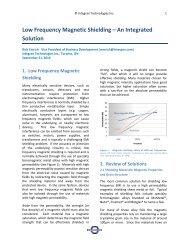

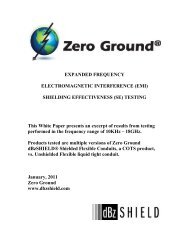
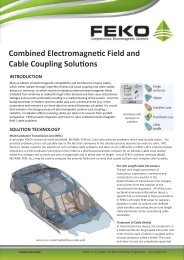

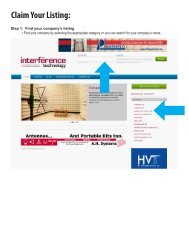

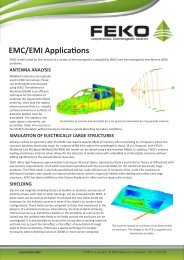
![[ thursday ] morning sessions 8:30 am-noon - Interference Technology](https://img.yumpu.com/23176841/1/190x247/-thursday-morning-sessions-830-am-noon-interference-technology.jpg?quality=85)
